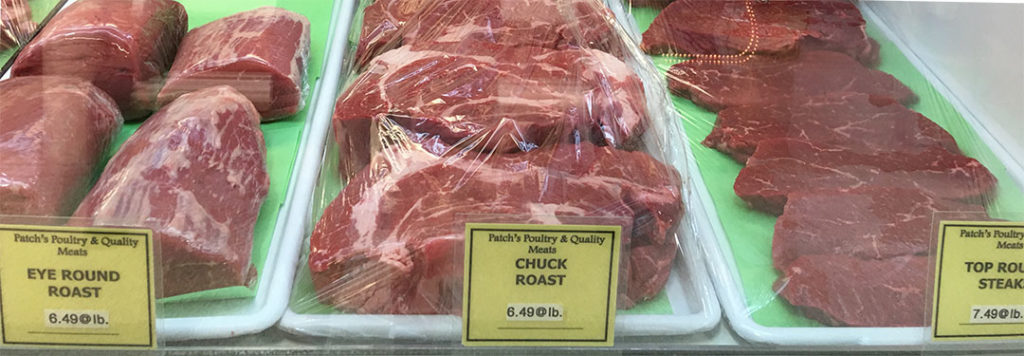Choosing top quality meats is a top quality concern, especially at the height of the end-of-summer barbecue and grilling season. Picking quality meats can be a tough task if you don’t know your chuck roast from your round roast or your brats from your kielbasa. As you’re shopping your local farmer’s market, follow these tips to ensure you bring home the best cuts of meat for a perfectly juicy, grilled meal.
Step 1: Which Meat Is Best For Your Meal?
To pick quality meats, your first step is to know what you’ll be cooking. Will you be grilling burgers at the summer picnic? Kabobs for Sunday dinner? Texas style brisket? Here’s a quick and easy guide to picking the right meat for your recipe:
- Showing off a marinade — Beef tri-tip (cross between steak and brisket)
- Savory dry rub — Skirt or flank steak (full flavored steaks)
- Perfectly grilled kabobs — Cubed sirloin (pre-cut cuts prep time in half)
- Juicy burgers — Any ground beef with at least 20% fat content (fat content = more juice)
- Most popular/easiest — Chicken Breast (boneless and/or skinless)
- Most versatile — Pork Chops (marinade or dry rub, grill or bake)
Step 2: Use Your Senses to Choose the Very Best
Once you’ve found yourself in the right cut of meat for your dish, use your senses to ensure you’re picking the best quality meat.
- Use Your Eyes: Pay attention to the color and marbling. Meat should have a color that is the same throughout the entire cut. There shouldn’t be any spots that are significantly lighter or darker than the rest. Be aware, however, that beef, lamb, and pork will have marbling. Marbling is streaks of fat that are found in the muscle. The marbling adds juiciness and flavor to the meat.
- Trust Your Nose: Another sense to use when picking the best quality meat is smell. The smell shouldn’t be off or funky in any way. There is a slight difference in smell between beef pork and chicken but the smell between meat types should not vary too much. Basically, if the meat smells rancid, it probably is.
- Pay Attention to the Firmness: When picking up the package of meat, the product should be firm but not tough to the touch. The meat should also give slightly when pressed but should not be soft enough to easily push through. Too soft or too firm indicates that the meat was poorly handled or it is past its prime.

Step 3: Understanding Your Food Labels
So, you’ve narrowed it down to several pieces of meat that meet your criteria. But some of them have labels that are unfamiliar to you. Here are some of the more common meat labels you may come across:
- GMO-Free: These pieces of meat are free of genetically modified organisms (GMOs).
- All Natural: According to FDA, all natural meat has no added color, artificial flavors, or synthetic substances.
- Organic: Choosing organic meat ensures that no pesticides, synthetic fertilizers, sewage sludge, GMOs, ionizing radiation, antibiotics or growth hormones have come in contact with your food. Some studies have shown that organic foods have a higher nutritional value.
- Certified Angus Beef: This designation proves that your meat is the absolute top quality by the USDA using 10 science-based specifications. Meat is graded using the “good, better, best” grading scale: Select, Choice, and Prime. Certified Angus Beef surpasses all categories.

Step 4: Keeping Your Quality Meat Fresh, Storage & Defrosting
You’ve chosen your meat, but not ready to use it. How do you store it and, if need be, how do you thaw it?
Meat should be refrigerated or frozen immediately after purchase. If you plan to freeze it, store the meat in a freezer bag and remove as much air from the bag as possible before freezing. This reduces the chance of unwanted freezer burn. Make sure you label the meat with the date that you froze it to ensure quality later down the road.
Pro Tip: wrap the meat in plastic wrap before putting in the freezer bag. Individual wrapping adds an extra barrier to prevent freezer burn. It also allows for easier access when it comes time to take the meat out of the freezer to thaw.
When ready for use, the best way to thaw frozen meat is by letting it sit in the refrigerator overnight. You can use the defrost setting on the microwave in a pinch, but it may cause the meat to lose some of its flavor. For a quicker remedy to thawing meats, place your meat, still in its freezer bag, in a dish of cold water and let sit for 30-40 minutes. Remember to never refreeze meat once thawed. Meats should always be used within two days of thawing.



